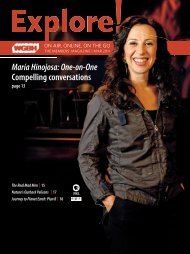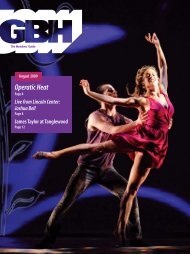Download program notes and libretto - WGBH
Download program notes and libretto - WGBH
Download program notes and libretto - WGBH
Create successful ePaper yourself
Turn your PDF publications into a flip-book with our unique Google optimized e-Paper software.
North of Germany was later to become his principal pastoral<br />
activity. Founded in Rome in 1524, the main object of the<br />
Theatin order was to recall the clergy to an edifying life, which<br />
would serve as an example for the laity, <strong>and</strong> thus a way to<br />
balance the Reformation. Supported by Pope Innocent XI, the<br />
Theatins founded oratories <strong>and</strong> hospitals, <strong>and</strong> devoted<br />
themselves to preach the Gospel <strong>and</strong> reform lax morals. In<br />
Bavaria, the Theatine Church St. Kajetan was founded by<br />
Elector Ferdin<strong>and</strong> Maria <strong>and</strong> his wife, Henriette Adélaïde of<br />
Savoy, as a gift of thanks for the birth of the long-awaited heir<br />
to the Bavarian crown, Maximilian Emanuel, in 1662. The<br />
dynastic continuity was essential for the monarchy, <strong>and</strong><br />
Orl<strong>and</strong>i makes this obsession an important part of Niobe’s<br />
character.<br />
VI<br />
Six children<br />
The children of Niobe were so numerous they were called the<br />
Niobids, <strong>and</strong> the exact number differs in the many ancient<br />
sources available to us. In Homer’s Iliad, like in Orl<strong>and</strong>i’s<br />
<strong>libretto</strong>, they are twelve (six boys <strong>and</strong> six girls): “For even the<br />
fair-haired Niobe bethought her of meat, albeit twelve children<br />
perished in her halls, six daughters <strong>and</strong> six lusty sons.The sons<br />
Apollo slew with shafts from his silver bow, being wroth<br />
against Niobe, <strong>and</strong> the daughters the archer Artemis [Diana],<br />
for that Niobe had matched herself with fair-cheeked Leto<br />
[Latona], saying that the goddess had borne but twain, while<br />
herself was mother to many; wherefore they, for all they were<br />
but twain, destroyed them all.” According to Sophocles’s<br />
Antigone,Apollodorus’s Library, <strong>and</strong> Ovid’s Metamorphoses,<br />
they are fourteen children, seven boys <strong>and</strong> seven girls. In<br />
Hesiod’s Catalogue of Women, they are eighteen. In all<br />
variations, an even number results in an equal quantity of boys<br />
<strong>and</strong> girls, as the number of Niobe’s children needs to speak to<br />
the imagination. Seneca, in his tragedy about Oedipus, gives<br />
another beautiful poetic twist to the number by saying that<br />
Niobe flattered her vanity over her children by also counting<br />
their shadows.<br />
This emphasis on a large number of offspring is not only the<br />
stuff of myth, but it was also the measure in the 1680s. France<br />
was a prime example: Louis XIV had a numerous family <strong>and</strong><br />
was very proud of it. By tradition a large quantity of children<br />
was a clear expression of virility <strong>and</strong> fertility, which was<br />
appealing to the imagination of the people. But from a dynastic<br />
perspective, after producing an heir, a large number of<br />
offspring allowed for the opportunity to create a large network<br />
of alliances through unions between the children of royal<br />
families. Indeed, in 1680, the French crown prince,The Gr<strong>and</strong><br />
Dauphin, married Maria Anna Victoria, Max Emanuel’s<br />
sister—the link between France <strong>and</strong> Bavaria was strong. Louis<br />
was hoping Max Emanuel would return the gesture <strong>and</strong> marry<br />
a French princess, but the Prince Elector was keen to keep a<br />
kind of independence <strong>and</strong> decided to balance the French union<br />
f e s t i va l o p e ra<br />
The death of the Niobids<br />
Dutch etching by Bernard Picart (1673–1733), Amsterdam, 1731, from the Temple<br />
of the Muses (Neu-Erofneer Musen-Tempel), Chatelain, Amsterdam <strong>and</strong> Leipzig,<br />
1733. Collection of Gilbert Blin.<br />
of his sister by marrying himself to an Austrian Princess. As<br />
Maria Antonia was also a niece of the Spanish king, the<br />
offspring of this union could give the Bavarian house a claim<br />
to the throne of Spain.<br />
When Steffani <strong>and</strong> his brother, poet Ventura Terzago, created<br />
the ballets for Servio Tullio for the Carnival of 1686, the first<br />
one to be celebrated in Munich by the newlywed couple, they<br />
showed their sense of allegory: in the first Ballet a number of<br />
gods, each more flattering to the couple than the one before,<br />
appear on a cloud machine. The gods announce a wondrous<br />
horoscope for the royal couple including the prediction of<br />
twelve children, which then, as in a vision of the future, appear<br />
as twelve dancers—six men <strong>and</strong> six women—on the stage.The<br />
horoscope was not at all farfetched, as Max Emanuel went on<br />
to have fourteen children with his two wives <strong>and</strong> his mistress.<br />
Of the fourteen children, seven died at an early age. In 1688,<br />
infant mortality was still common, even in the highest class of<br />
society.The killing of the Niobids by Apollo the sun <strong>and</strong> Diana<br />
the moon may also been a cruel allegory of the death of<br />
children in one day <strong>and</strong> in one night. Seventeenth-century<br />
commentators remind us that Cicero, reflecting on the final<br />
141<br />
2 0 1 1 b o s t o n e a r l y m u s i c f e s t i v a l<br />
NIOBE, REGINA DI TEBE

















